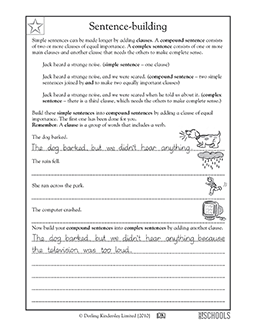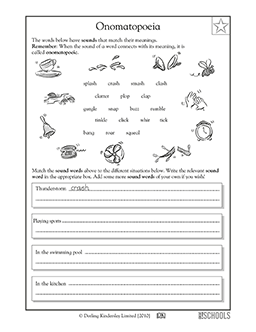- Reading is an ongoing lesson. Our 5th grade reading and writing worksheets focus on literacy for 10 and 11 year olds. Your child will hone their reading skills with grammar worksheets, simple summary writing guides, fill-in-the-blank stories, and more. Make learning enjoyable in the classroom or at home with fifth grade reading and writing.
- Eleventh Grade Creative Writing Worksheets Prepare your eleventh-grade students for college and beyond, with our most popular creative writing printables. These activities will help your class perfect their writing, creative, and analytical skills.
In the comment box below, include your idea for a great writing warm-up, with a description of how to go about doing it, and I will add it to the list with your name attached, if you would like. Important note: writing warm-ups, particularly collaborative writing, get better over time. Students need to develop the skills associated with it. Students receiving a 3 or 4 on the ELA Smarter Balanced Assessment (SBAC) at the end of their sophomore year can begin selecting ELA classes from the following categories for their 11th and 12th grade ELA classes. High School: Grades 11 & 12 Courses: African American Lit Bridge to College English Creative Writing Mythology Native American Lit. As children progress through school, more rules are associated with writing. Using teacher-created printable third grade reading and writing worksheets, your child can practice these rules through engaging activities. With interesting story comparisons, whimsical word searches, and useful lists, third grade writing is a breeze.
Grade 6 ELA: Writing |
|---|
Educational Materials for Grade 6 ELA: English Language Arts - 6th Grade Curriculum - 6th Grade Math |
|---|
CCSS.ELA-LITERACY.W.6.1: Write arguments to support claims with clear reasons and relevant evidence. |
|---|
8th Grade Ela Worksheets Printable
CCSS.ELA-LITERACY.W.6.1.A: Introduce claim(s) and organize the reasons and evidence clearly. |
|---|
| I want a.. Persuasive Argument Graphic Organizer |
CCSS.ELA-LITERACY.W.6.1.B: Support claim(s) with clear reasons and relevant evidence, using credible sources and demonstrating an understanding of the topic or text. |
|---|
CCSS.ELA-LITERACY.W.6.1.C: Use words, phrases, and clauses to clarify the relationships among claim(s) and reasons. |
|---|
CCSS.ELA-LITERACY.W.6.1.D: Establish and maintain a formal style. |
|---|
CCSS.ELA-LITERACY.W.6.1.E: Provide a concluding statement or section that follows from the argument presented. |
|---|
CCSS.ELA-LITERACY.W.6.2: Write informative/explanatory texts to examine a topic and convey ideas, concepts, and information through the selection, organization, and analysis of relevant content. |
|---|
CCSS.ELA-LITERACY.W.6.2.A: Introduce a topic; organize ideas, concepts, and information, using strategies such as definition, classification, comparison/contrast, and cause/effect; include formatting (e.g., headings), graphics (e.g., charts, tables), and multimedia when useful to aiding comprehension. |
|---|
CCSS.ELA-LITERACY.W.6.2.B: Develop the topic with relevant facts, definitions, concrete details, quotations, or other information and examples. |
|---|
CCSS.ELA-LITERACY.W.6.2.C: Use appropriate transitions to clarify the relationships among ideas and concepts. |
|---|
CCSS.ELA-LITERACY.W.6.2.D: Use precise language and domain-specific vocabulary to inform about or explain the topic. |
|---|
CCSS.ELA-LITERACY.W.6.2.E: Establish and maintain a formal style. |
|---|
CCSS.ELA-LITERACY.W.6.2.F: Provide a concluding statement or section that follows from the information or explanation presented. |
|---|
CCSS.ELA-LITERACY.W.6.3: Write narratives to develop real or imagined experiences or events using effective technique, relevant descriptive details, and well-structured event sequences. |
|---|
CCSS.ELA-LITERACY.W.6.3.A: Engage and orient the reader by establishing a context and introducing a narrator and/or characters; organize an event sequence that unfolds naturally and logically. |
|---|
CCSS.ELA-LITERACY.W.6.3.B: Use narrative techniques, such as dialogue, pacing, and description, to develop experiences, events, and/or characters. |
|---|
CCSS.ELA-LITERACY.W.6.3.C: Use a variety of transition words, phrases, and clauses to convey sequence and signal shifts from one time frame or setting to another. |
|---|
CCSS.ELA-LITERACY.W.6.3.D: Use precise words and phrases, relevant descriptive details, and sensory language to convey experiences and events. |
|---|
CCSS.ELA-LITERACY.W.6.3.E: Provide a conclusion that follows from the narrated experiences or events. |
|---|
CCSS.ELA-LITERACY.W.6.4: Produce clear and coherent writing in which the development, organization, and style are appropriate to task, purpose, and audience. (Grade-specific expectations for writing types are defined in standards 1-3 above.) |
|---|
Creative Writing Club8th Grade Ela Pages
CCSS.ELA-LITERACY.W.6.5: With some guidance and support from peers and adults, develop and strengthen writing as needed by planning, revising, editing, rewriting, or trying a new approach. (Editing for conventions should demonstrate command of Language standards 1-3 up to and including grade 6 here.) |
|---|
CCSS.ELA-LITERACY.W.6.6: Use technology, including the Internet, to produce and publish writing as well as to interact and collaborate with others; demonstrate sufficient command of keyboarding skills to type a minimum of three pages in a single sitting. |
|---|
CCSS.ELA-LITERACY.W.6.7: Conduct short research projects to answer a question, drawing on several sources and refocusing the inquiry when appropriate. |
|---|
CCSS.ELA-LITERACY.W.6.8: Gather relevant information from multiple print and digital sources; assess the credibility of each source; and quote or paraphrase the data and conclusions of others while avoiding plagiarism and providing basic bibliographic information for sources. |
|---|
CCSS.ELA-LITERACY.W.6.9: Draw evidence from literary or informational texts to support analysis, reflection, and research. |
|---|
CCSS.ELA-LITERACY.W.6.9.A: Apply grade 6 Reading standards to literature (e.g., 'Compare and contrast texts in different forms or genres [e.g., stories and poems; historical novels and fantasy stories] in terms of their approaches to similar themes and topics'). |
|---|
CCSS.ELA-LITERACY.W.6.9.B: Apply grade 6 Reading standards to literary nonfiction (e.g., 'Trace and evaluate the argument and specific claims in a text, distinguishing claims that are supported by reasons and evidence from claims that are not'). |
|---|
CCSS.ELA-LITERACY.W.6.10: Write routinely over extended time frames (time for research, reflection, and revision) and shorter time frames (a single sitting or a day or two) for a range of discipline-specific tasks, purposes, and audiences. |
|---|


Start each question on a NEW page and rule off on completion of. IXL brings grade 9 English language arts to life! The question was ‘Write a Story about a Game that goes Wrong’, which is Question 5 on the AQA Specimen 3 Language paper GRADE 9 NOVEMBER 2012 ENGLISH FIRST ADDITIONAL LANGUAGE MARKS: 100 TIME: 2 hours This question paper consists of 9 pages. Use our most popular printables to enhance your class's abilities at comprehending story elements, genre, and meaning CCSS.ELA-Literacy.W.9-10.5 Develop and strengthen writing as needed by planning, revising, editing, rewriting, or trying a new approach, focusing on addressing what is most significant for a specific purpose and audience. Creative Writing in GCSE exams can take various forms: You may just help essay titles have to tell an entire short story or you could be asked to write a description of a picture. SECTION C: SUMMARY (10 marks) SECTION D: CREATIVE WRITING (20 marks) 2. Grade 9 English GCSE Creative Writing 40 Mark Example AQA GCSE English Language Exam 8700 english language creative writing grade 9 Paper 1,2 2nd, 4th Nov 2020 - Exam Discussion Poppies vs Remains Comparison - Please help!
English Home Language is compulsory for all students at the school. (Editing for conventions should demonstrate command of Language standards 1-3 up to and including grades 9-10 here.). Download frostwire for macbook air. This video shows you two examples of work done by real GCSE English students in exam conditions. This is a model answer for AQA English creative writing jobs in south africa Language paper 1 question 5. Areas covered by CAPS include Creative Writing, Functional Writing, Investigation and Presentation, Oral Communication Skills and Responding to Text (Senior: Grades 10–12 and Junior: Grades english language creative writing grade 9 8–9).They'll be inspired by these poetry and story-writing activities and lessons.
Here are some top…. Share 0. It was given 37 marks (23 AO5 and 14 AO6) so it is a Grade 9. This is also known (mostly by teachers) english language creative writing grade 9 as narrative writing. It also has comments by a marker on the responses. Creative writing can be daunting for some as there’s no extract to follow, it’s whatever you decide to. Grade 9 English GCSE Creative Writing 40 Mark Example AQA GCSE English Language Exam 8700 Paper 1,2 2nd, 4th Nov 2020 - Exam Discussion OCR A level English Literature 2019. Grade 9 Gcse English Creative Writing. Grade 9 english creative writing.
Creative Writing Club8th Grade Ela Page
